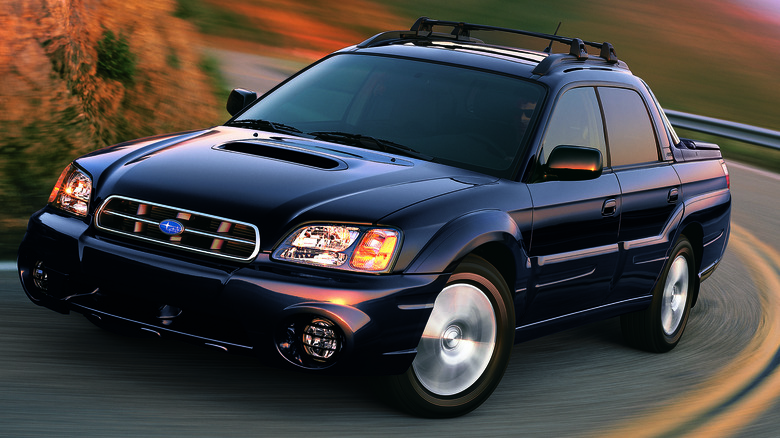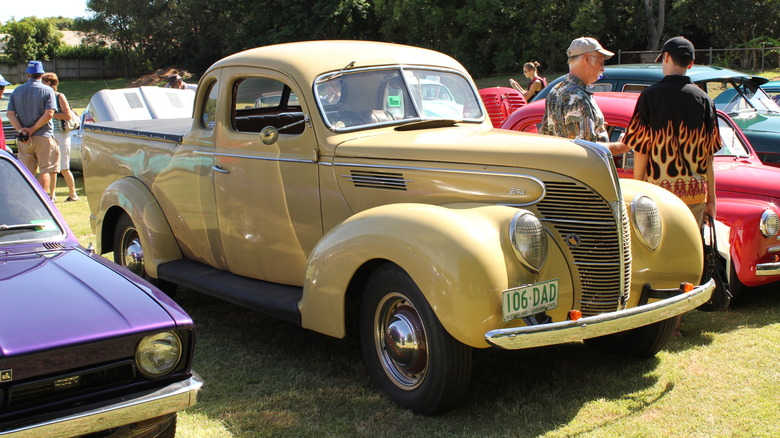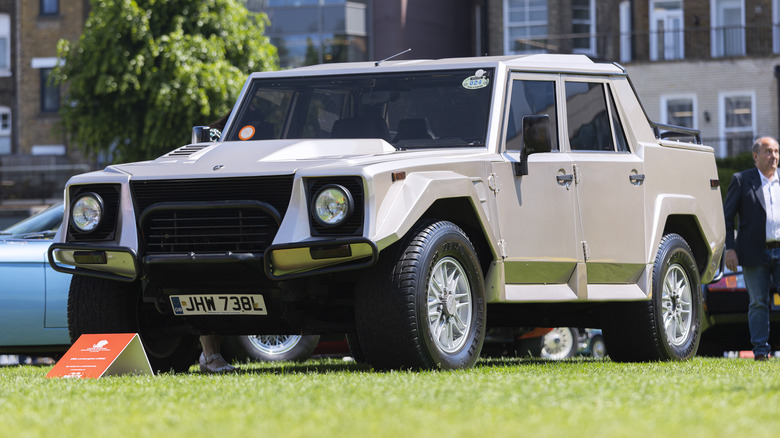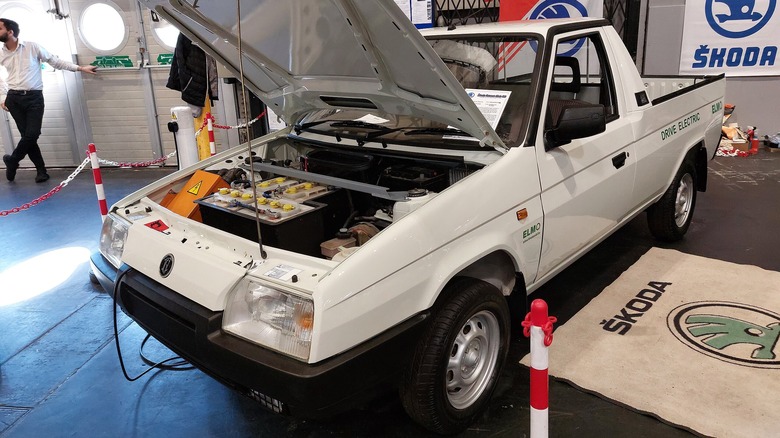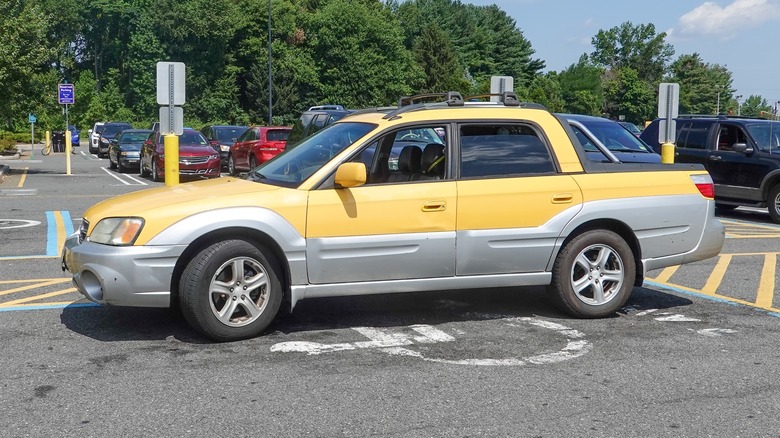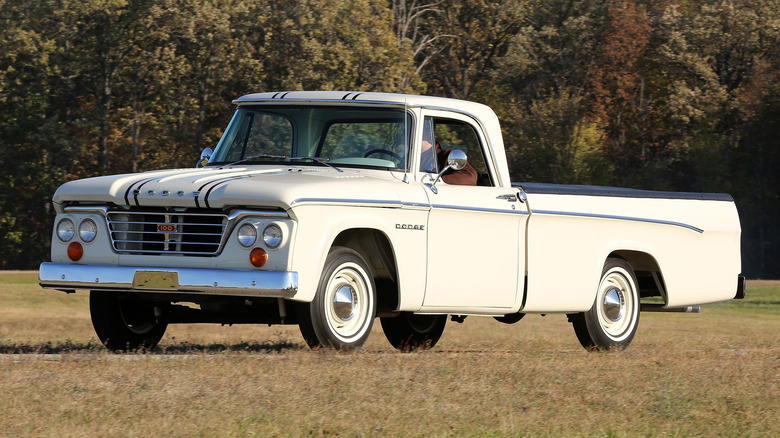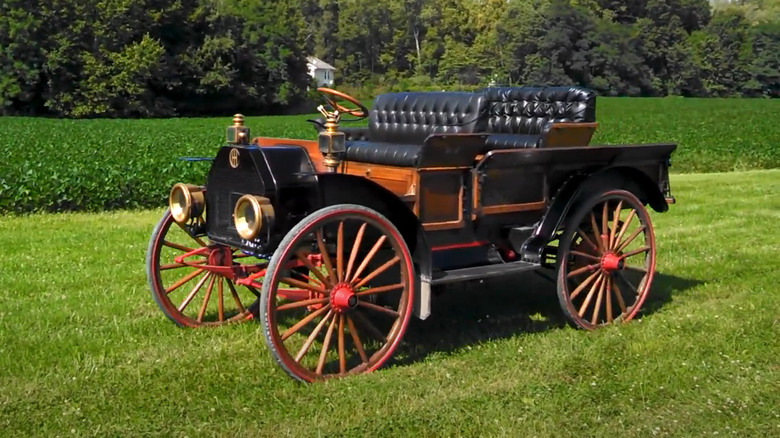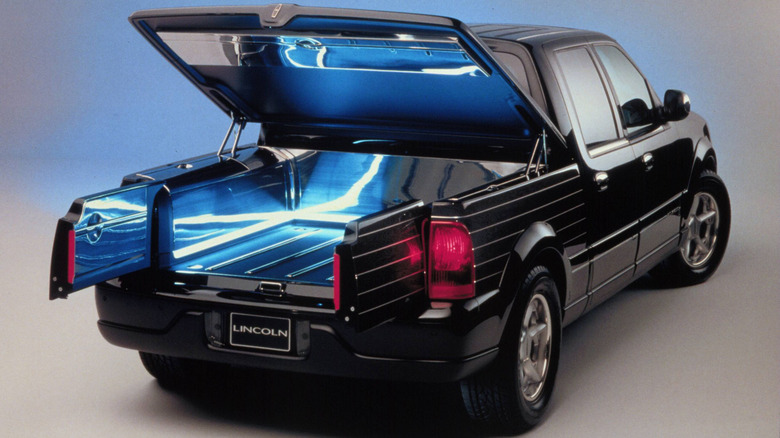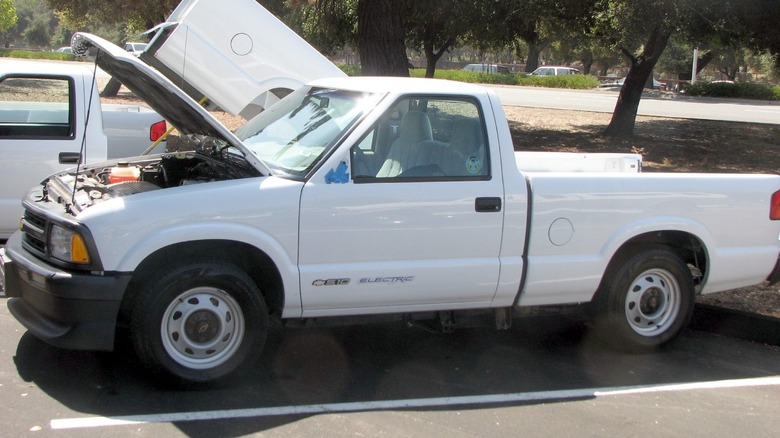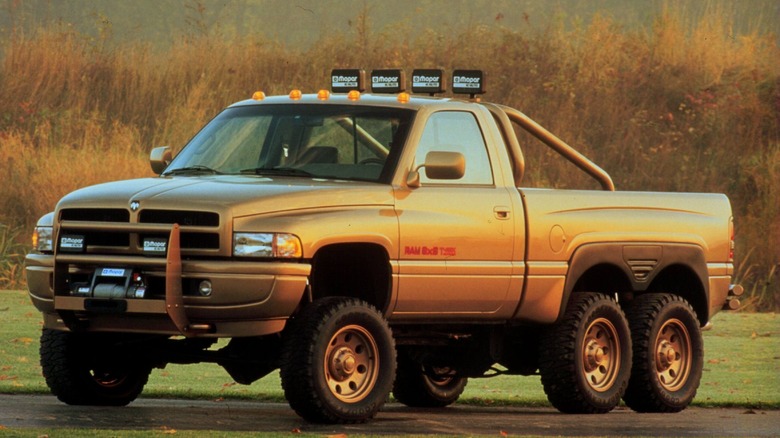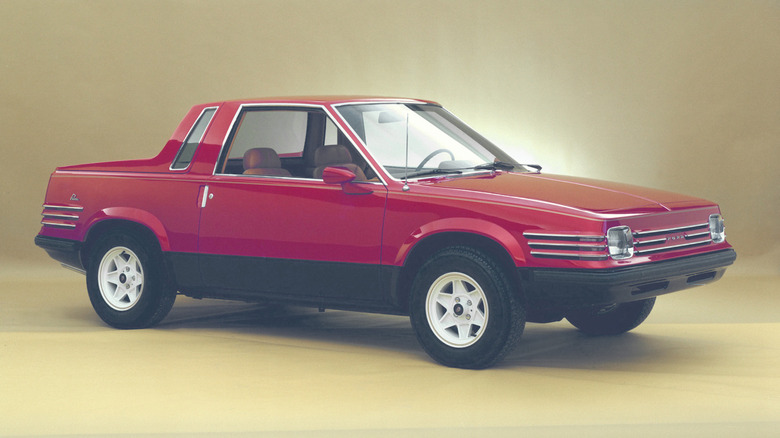10 Pickup Trucks That Were Way Ahead Of Their Time
The pickup truck market is currently undergoing its most drastic change in decades as electric pickups are launched alongside their gas and diesel-powered counterparts, but that's not the only way the market is changing. Smaller compact pickups are seeing a resurgence in popularity, and, on the other end of the scale, outrageously overpowered all-terrain trucks are now more readily available than ever, thanks to the increasing range of offerings from both major manufacturers and specialist conversion outfits.
With all these recent changes, it can be easy to forget that many of these seemingly new trends aren't quite as new as they might first appear. Many go back decades, although the models that first pioneered these ideas aren't always well remembered. From forgotten Hemi-powered muscle trucks to a Czech EV pickup that most enthusiasts will never have heard of, these 10 trucks all proved to be ahead of their time, debuting ideas that slowly became more commonplace in the decades since their unveiling.
Ford Coupe Utility
The Ford Ranchero and Chevrolet El Camino popularized the idea of a pickup truck that could serve double duty as a comfortable passenger car. The first generation Ranchero launched in America in 1957, but more than two decades before, Ford had already begun building a similarly versatile pickup in Australia. Debuting in 1934, the Ford Coupe Utility was conceived in response to a letter that Ford Australia received from a farmer's wife.
The woman complained that existing car-based pickup trucks were too rudimentary and uncomfortable and wanted something that combined the ride comfort and conveniences of a modern passenger car with the practicality of a pickup. Per Shannon's, she wrote: "We need a car to go to church on Sunday and a truck to take the pigs to market on Monday."
Ford bosses liked the idea and adapted the design of its Model 40 coupe to incorporate a generously sized pickup bed. It connected with Australian buyers and marked the beginning of the country's decades-long penchant for utes. The Coupe Utility wasn't the only vehicle of its kind — the U.S. market Hudson Terraplane Express followed a similar formula, but it was the Aussie Ford that formed the blueprint for future models.
[Featured image by NJM2010 via Wikimedia Commons | Cropped and scaled | CC BY-SA 3.0]
Lamborghini LM002
Throughout the late '70s and early '80s, Lamborghini had tried and failed to design a military truck that would allow it to win lucrative U.S. Army contracts. It finally gave up on the idea after running out of cash and being bought out by new ownership, but its new owners didn't want to let the project go to waste. They decided to relaunch the truck as a civilian vehicle, complete with the V12 engine from the Countach. The result was the legendary LM002, an outlandish vehicle that it still makes many of today's super-SUVs look tame.
Decades before the arrival of modern overpowered all-terrain trucks like the Ford F-150 Raptor R and Ram 1500 TRX, the LM002 boasted a 444 horsepower engine, a sky-high price tag, and tires wider than virtually any other production vehicle at the time. Its bed was small, high-sided, and barely qualified it as a pickup — in fact, it's often labeled as Lamborghini's first off-road SUV. Lamborghini carefully avoids calling it either an SUV or pickup, labeling it an "off-road vehicle" that became "a forerunner of [later] high-powered SUVs." Yet, it has a bed, albeit a small one. Let's call it a pickup, and a pioneering one at that.
Skoda Elmo
It seems that every pickup truck owner has an opinion on electric trucks. Some love them, some hate them. Either way, they're here to stay for the foreseeable future. Ford launched its F-150 Lightning in 2022, and GM released electric Chevrolet and GMC pickups for 2024, but they've been around for far longer. The Skoda Elmo pickup is a little-known predecessor to the modern electric pickup that was unveiled in 1991, the same year that Volkswagen Group first took a stake in the Czech automaker.
The Elmo, called the Eltra 151 L in some European markets, was based on Skoda's Favorit compact car. It featured a range of up to 50 miles and was offered primarily to local authorities in markets like Switzerland and the UK. Strangely, it featured a four-speed manual transmission which had been specially adapted from the gas-powered Favorit. Most owners reportedly spent most of their time driving in third gear, which could be used to take off from standstill and cruise around at city traffic speeds.
It's not known how many examples of the truck were built, but with Skoda's dire financial situation at the time, it didn't make sense to continue producing the truck. With Volkswagen's help, Skoda transformed itself into a profitable automaker, but in the process, the world's first commercially available electric pickup truck was axed.
[Featured image by kieranwhite599 via Wikimedia Commons | Cropped and scaled | CC BY 2.0]
Subaru Baja
The Baja wasn't the Japanese automaker's first attempt at a pickup truck — that honor goes to the Brat. However, it was the Baja that managed to most accurately predict the design of modern small car-based trucks. Strong interest in the Ford Maverick and, to a lesser degree, the Hyundai Santa Cruz proves there's now a market for such small, compact pickups, and as such, there's an argument to be made for a Baja revival for a new generation.
The Baja was essentially an extended version of the Outback SUV, in the same way that today's Ford Maverick shares a platform with the Escape and Bronco Sport. It featured several clever innovations, including an opening to allow long cargo to be partially placed in the back of the cabin and the same all-terrain chops that drew buyers to the Outback. However, it never sold well. Buyers weren't interested in a small, practical car-based pickup at the time, but as Ford and Hyundai have proved, that's no longer the case today.
Dodge Custom Sport Special
Demand for street trucks peaked a few decades ago, with the likes of the GMC Syclone and Ford SVT Lightning garnering cult fanbases while leaving foreign exotics in the rearview at stoplights. Long before that peak, the 1964 Custom Sport Special followed a similar recipe, although it remains largely overlooked today.Before anyone had coined such a term, it was a factory-spec muscle truck with a 365-horsepower Hemi 426 V8 and bucket seats. The engine was mated to a three-speed automatic and heavy duty springs helped keep the truck stable despite its added power.
It was an extremely rare truck at the time, and is even rarer today. Just 50 units were reportedly built, with each one costing an almost 70% premium over an entry-level D100, according to MotorTrend. Each one had to be hand-built with a slew of bespoke parts, making it both a labor-intensive and largely unprofitable model. It's not known exactly how many examples survive today.
IHC Auto Wagon
Even in the early days of the motorcar, buyers wanted versatility from their light trucks. The 1907 IHC Auto Wagon might look very different than today's pickups, but its job was exactly the same — transport people and cargo as efficiently as possible. It boasted removable rear seats, which was an innovative way to maximize passenger capacity without compromising on cargo space. The open design of the truck meant that removing the rear row of seats was simply a question of unbolting them and storing them until they were needed again.
During the working week, the truck's bed could be used to its full capacity. Then, come the weekend, the rear seats could be bolted back on to sit directly above the bed, turning it into a family vehicle. A brochure from the era noted "while this car is designed for commercial purposes only, there is no reason why it cannot be used as a pleasure vehicle when occasion demands."
Removable seats would later become a common option on minivans, while today's popular crossovers and SUVs mostly feature fold-flat seats instead. Even if modern vehicles now offer a sleeker system than the Auto Wagon, the idea of being able to quickly swap between cargo-carrying and passenger-carrying layouts proved to be a pioneering one and remains a sought-after feature for many buyers today.
Lincoln Blackwood
The Lincoln Blackwood is one of the most frequently cited examples of a truck that was ahead of its time, because it pioneered the idea of a luxury pickup truck but never caught on with buyers. It was launched in 2002 and axed after just one year thanks to dismal sales figures. It made no effort to appear work-ready, with its carpeted bed and hydraulic tonneau bed cover making it impractical to do most traditional truck stuff. The interior was also more luxurious than any other truck on the market, with liberally applied leather upholstery and oak trim.
In one sense, the Blackwood was very much ahead of its time. The market for luxury trucks is now a large and lucrative one, and it's likely that Lincoln would now see significantly higher sales if it launched a modern equivalent. However, there's one important distinction between the marketing of modern luxury trucks and the marketing of the Blackwood: most modern luxury trucks make more effort to keep up the pretense of being work-ready.
In reality, neither the Blackwood nor its modern successors are likely to be used for much more than a weekend Home Depot run. However, convincing buyers that they could do truck stuff with their luxury barge seems to have been the key to persuading them to open their wallets.
Chevy S-10 EV
America's first production electric pickup truck was the Chevy S-10 EV, based on the GM EV1. When it launched in 1997, the base truck reportedly offered a range of up to 60 miles at speeds of 45 mph or 39 miles at speeds of 60 mph. Those figures were not exceptional even at the time; the GM EV1 achieved up to 140 miles on a charge, but were enough to make the truck a viable proposition for city driving. Jalopnik reports that an upgraded battery pack with up to 130 miles of range was also available.
The S-10 EV1 could have been the first step to developing practical, appealing electric trucks like those that are just starting to appear on the market today, but GM decided to ax the development program after California scrapped its EV mandate. It would take until the launch of the 2024 Silverado EV for a successor to come along, with the modern Silverado now offering a much more practical 450 miles of range.
[Featured image by Mike Weston via Wikimedia Commons | Cropped and scaled | CC BY 2.0]
Dodge T-Rex
While 6x6 trucks remain a niche segment, they're no longer as much of a novelty as they once were. The Mercedes G63 AMG 6x6 continues to be popular with well-heeled collectors, and a range of specialist outfits, including Hennessey, Kahn Design, and Rezvani, all offer 6x6 trucks on a commission-only basis. Back in 1997, the idea of a civilian 6x6 truck was still a strange one, but that didn't stop Dodge from unveiling the one-off T-Rex 6x6 at SEMA in 1997.
The truck followed what has now become a familiar formula for 6x6 trucks. It packed a high-powered engine, in this case, a 497 horsepower V19 plucked from the Viper and beefed-up tires and suspension to make it an off-road monster. Dodge never put the truck into production, but DaimlerChrysler stablemate Mercedes-Benz would later produce a 6x6 G-Class for the Australian military. In turn, that truck would become the infamous G63 AMG 6x6. The modern Ram 1500 TRX could also be considered a successor, as it ditched the extra pair of axles, but kept the high-powered engine and off-road chops.
Ford Ghia Prima
The modern crossover combines elements of various segments into one versatile car. However, nothing on the market today combines them quite as literally as the Ford Ghia Prima concept of 1976. In its standard form, the Ghia Prima was a tiny pickup truck, but thanks to a series of removable rear canopies, it could be transformed into a station wagon, coupe, or fastback. Ghia's director described it at the time as an "idea car" that wasn't meant for production but would instead "test public reaction" to "possible transportation [ideas] of the future."
The Ghia Prima was based on the Fiesta and so was far smaller than any pickups on the American market today. A Fiesta-based pickup would eventually be produced in the form of the South African-market Bantam. Still, it never featured anything like the innovative interchangeable roof system proposed by the Ghia concept.
